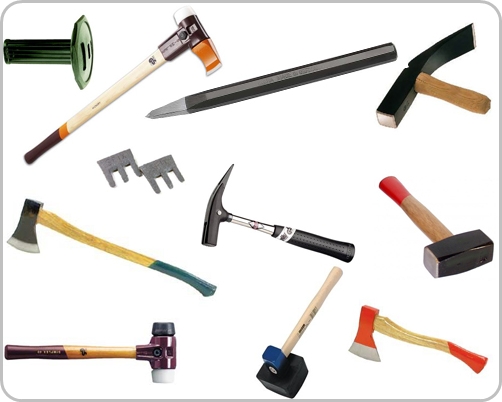 The hammer is the oldest tool, that we know. The hand ax of our early ancestors has evolved over the millennia into a tool with many shapes for many uses.
The hammer is the oldest tool, that we know. The hand ax of our early ancestors has evolved over the millennia into a tool with many shapes for many uses.
You will definitely find a hammer in every household, whether in the hobby room on the tool wall or between adhesive tape and a can opener in the kitchen drawer. There are hammers for a wide variety of jobs, from the fine, light glass hammer to 10 kg heavy sledgehammer.
UNIVERSAL HAMMERS
The most common form of hammer is the locksmith's hammer, either | with wooden handle and steel sleeve (1) or with a plastic handle (2). It has a blunt square track at the front of the hammer head (face) and at the back the horizontal wedge-shaped fin. The carpenter's hammer (3) has a slightly different head shape, but is just as versatile. Machinist's hammers weigh in between 0,5 kg and 2 kg. Carpenter's hammers are classified according to face size (16 to 36 mm).
FLAIL
When working with wood with chisels and chisels, you should use wooden flails, to protect the wooden handles of the grooving tools. Mallets can do that (4) be or club (5 + 7). Not only popular with wood sculptors: Mallet with bronze head (6).
HEAVY HAMMERS
If a higher impact power is desired, for example when paving, you grab a short fist (8), the until 8 can weigh kg. In order not to damage the surface of the paving stones, you put a block of wood underneath or put on a rubber or plastic striking surface (11). Should fence- or tree stakes driven into the ground, becomes a sledgehammer (9 + 10) deployed, it up to 10 kg weight there. They can also be used to drive in wedges when felling trees or to smash stones. Thanks to the long handle, smaller walls can also be effectively demolished with the sledgehammer.
SCHONHAMMER
In order not to leave traces of processing on material surfaces, There are soft-face mallets with heads made of rubber or plastic. This model (12) has a steel ball filling, which prevents the hammer from snapping back. The hammer with a solid rubber head is widespread (13) and the one with inexpensive interchangeable heads made of plastic of different hardness (14).
BAUHÄMMER
There are a number of special hammers available from builders. The carpenter needs the Lathamer (15), with the point of which he draws boards and beams. A groove with a holding magnet secures a nail and allows a nail to be set with one hand (S. 44 Photo left). The second hand is free, for example to hold the board or belay yourself. With the claw hammer (16) incorrectly set or crooked nails can be pulled out again. The plasterer's ax is a hammer and ax in one (17). The mason's hammer (18) serves to set the bricks in the mortar bed and to divide the stones. the welder- hammer (19) Is used, around the slag, which occurs on the weld seam during welding, to remove. The slag is knocked off immediately after it has solidified.
Track and fin each have a different ground shape. The long tip of the roofing hammer (20) is specially designed for splitting and adjusting roof tiles.
SMALL HAMMER
There are special hammers for a lot of fine work, not only in the lower weight, but also differ in shape from the standard hammer. The small hammer for decorators (21) is ideal for small nails and wallpaper sticks. A special hammer, that holds nails with its magnetic head (22). The goldsmith's hammer (23) has a polished trajectory, which protects the fine material, and the glazier's hammer (24) a trapezoidal path, with which it is guided on the glass, when the pane is fixed in the frame with pins.
SPECIAL HAMMERS
The veneer hammer (25) can be recognized by its wide fin (for rubbing), the engineer hammer (26) is originally a locksmith's hammer (english form). For work in areas where there is a risk of fire, such as petrol stations or tankers, use a non-sparking copper hammer (27). For sheet metal forming, for example in the event of bodywork damage to the car, you use driving hammers (28 + 29) a. These hammers are available with differently curved hammer faces, which are thus adapted to the workpiece curvature. Myth dem Dengelhammer (30) the cutting edge is driven out by scythes.
Hammerhart
Track and fin are heavily loaded. A special manufacturing process gives them the necessary hardness.
Quality hammer heads are machined from red hot, high-quality tool steel in a double die (upper and lower forging mold) made as a blank. The hole is already made during this process (Eye) punched out for the stem. Casting seams are removed and the surface smoothed by grinding on appropriate machines. Then comes the hardening, a job, which requires a lot of experience. It must be the point – sufficiently hard, but without being brittle – to be hit. The hammer heads are then sandblasted and given their final appearance.
Hammer handles come in a variety of designs, for example: lacquered ash wood, Lacquered hickory wood with nickel-plated impact protection sleeve, plastic-coated steel handle, Steel handle with plastic handle. The prices for these hammers are between 15,20 and 37,20 Euro.